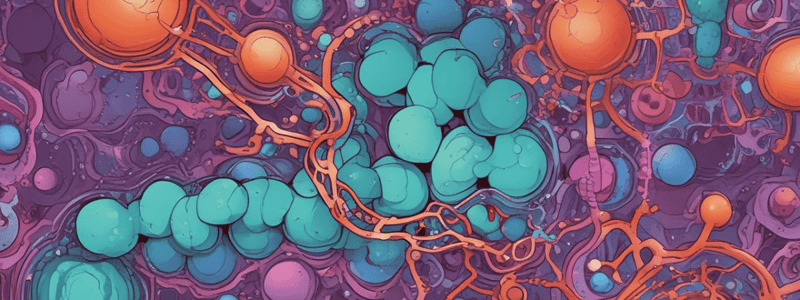Podcast
Questions and Answers
What is the primary difference between passive and active transport?
What is the primary difference between passive and active transport?
- Type of solute transported
- Energy requirement (correct)
- Location of transport
- Direction of transport
Which type of transporter facilitates the passive movement of a single solute?
Which type of transporter facilitates the passive movement of a single solute?
- ATP-driven pump
- Coupled transporter
- Uniporter (correct)
- Symporter
What drives the transport of solutes through symporters?
What drives the transport of solutes through symporters?
- Transport of a second solute in the same direction (correct)
- Hydrolysis of ATP
- Electrochemical gradients
- Concentration gradients
How do ATP-driven pumps transport solutes?
How do ATP-driven pumps transport solutes?
What is the primary function of ATP-driven pumps?
What is the primary function of ATP-driven pumps?
What is the role of conformational changes in mediated transport?
What is the role of conformational changes in mediated transport?
Which type of ATP-driven pumps phosphorylate themselves during the pumping cycle?
Which type of ATP-driven pumps phosphorylate themselves during the pumping cycle?
What is the primary function of V-type pumps?
What is the primary function of V-type pumps?
What is the advantage of ion channels over transporters?
What is the advantage of ion channels over transporters?
What is the primary function of aquaporins?
What is the primary function of aquaporins?
What is the main factor that determines the diffusion rate of a molecule across a protein-free lipid bilayer?
What is the main factor that determines the diffusion rate of a molecule across a protein-free lipid bilayer?
Why are protein-free lipid bilayers impermeable to charged molecules?
Why are protein-free lipid bilayers impermeable to charged molecules?
What is the primary function of a transporter protein?
What is the primary function of a transporter protein?
What is the main difference between transporter and channel proteins?
What is the main difference between transporter and channel proteins?
Which of the following molecules is most likely to diffuse rapidly across a protein-free lipid bilayer?
Which of the following molecules is most likely to diffuse rapidly across a protein-free lipid bilayer?
What is the main difference between ion channels and aqueous pores?
What is the main difference between ion channels and aqueous pores?
What is the purpose of narrow pores in ion channels?
What is the purpose of narrow pores in ion channels?
What is the main mechanism by which mechanically gated channels are activated?
What is the main mechanism by which mechanically gated channels are activated?
What is the main factor that contributes to the membrane potential in animal cells?
What is the main factor that contributes to the membrane potential in animal cells?
What is the function of gated channels in ion channels?
What is the function of gated channels in ion channels?
Flashcards are hidden until you start studying
Study Notes
ATP-driven Pumps
- ATP-driven pumps, also known as transport ATPases, hydrolyze ATP to ADP and phosphate, using the energy released to pump ions or other solutes across a membrane.
- There are three types of ATP-driven pumps: P-type, ABC transporters, and V-type pumps.
P-type Pumps
- Structurally and functionally related to multipass transmembrane proteins.
- Phosphorylate themselves during the pumping cycle.
- Responsible for setting up and maintaining gradients of Na+, K+, H+, and Ca2+ across cell membranes.
ABC Transporters
- Primarily pump small organic molecules across cell membranes.
V-type Pumps
- Turbine-like protein machines constructed from multiple different subunits.
- Transfer H+ into organelles, such as lysosomes, synaptic vesicles, and plant or yeast vacuoles, to acidify the interior of these organelles.
Channels and Electrical Properties of Membranes
- Ion channels are membrane proteins that form narrow, highly selective pores, allowing specific inorganic ions to diffuse rapidly down their electrochemical gradients.
- Ion channels are classified into voltage-gated, mechanically gated, and ligand-gated channels.
Ion Selectivity and Gating
- Ion channels are ion-selective, permitting some inorganic ions to pass while blocking others.
- Ion channels fluctuate between open and closed states, controlled by gating mechanisms such as voltage, mechanical stress, or ligand binding.
Aquaporins and Water Transport
- Aquaporins are water channels that allow water to move rapidly across the membrane.
- Found in cells that require high water transport rates, such as epithelial cells in the kidney or exocrine cells.
Membrane Transport Proteins
- Two main classes of membrane transport proteins: transporters and channels.
- Transporters bind specific solutes and undergo conformational changes to transport solutes across the membrane.
- Channels form continuous pores that allow specific solutes to pass through the membrane.
Active Transport and Energy Sources
- Active transport involves the movement of solutes against their concentration or electrochemical gradient.
- Requires an input of metabolic energy, which can be coupled to the hydrolysis of ATP or the energy stored in concentration gradients.
Uniporters, Symporters, and Coupled Transport
- Uniporters facilitate the passive movement of a single solute across the membrane.
- Symporters (co-transporters) transfer one solute strictly dependent on the transport of another solute.
- Coupled transport involves the intimately coupled transfer of two solutes in the same direction.
Studying That Suits You
Use AI to generate personalized quizzes and flashcards to suit your learning preferences.




